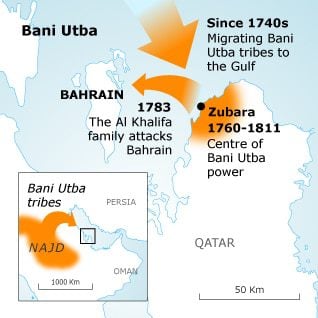
The British - Al-Khalifa Alliance
The ancestors of the present ruling family of Bahrain, the Al-Khalifa, were among the Sunni Bedouin tribes, known collectively as the Bani Utba/the Utub, who migrated from central Arabia to Kuwait in the early 18th century. In 1766 the Al-Khalifa was among the group of Utub that sailed from Kuwait to the Qatar promontory, settling on its north-western shore. This location was convenient to the rich pearl banks of Bahrain, where these Utub clans had commercial interests while they resided in Kuwait.
In 1782, restless Utub tribesmen moved onto the Bahrain islands – then controlled by the Persians through an Omani governor – provoking an unsuccessful Persian-Omani attempt to expel the Utub from the area in 1783. In the wake of their surprising victory, more Utub settled on the overwhelmingly Shiite Bahrain islands.
As a result of the victory of the Utub over the Persians, the Al-Khalifa clan gained political supremacy in the archipelago. The present dynasty’s founding father, Ahmed bin Khalifa (known as al-Fatih, the Conqueror), who ruled until 1794, successfully thwarted Omani and Persian attempts to re-establish their authority. But Ahmed’s jointly ruling sons, Salman and Abdullah, were less successful and were temporarily reduced to the status of vassal of the Al Saud of Najd and the ruler of Oman respectively.
On the death of Salman in 1825 the ruling family split into two competing branches. Each of the feuding sub-clans, one based in Manama and the other in Qatar, was supported by foreign allies. From time to time the islands were engulfed by violence, with the members of the wealthy local Indian merchant community – protected subjects of the British Raj in India – as typical targets.
The British East India Company had been present in the Gulf since the early 17th century. In 1816 the Company’s representative in Persia – the so-called Resident, in Bushehr (Bushire) – had visited Bahrain at the invitation of co-ruler Abdullah. They had signed an agreement of friendship which, in addition to encouraging peaceful mutual trade, allowed for the establishment of a company agency in Bahrain. The first ‘native’ company agent, a local Hindu merchant, was soon installed. This appointment marks the beginning of British-Indian political influence on Bahraini domestic and foreign affairs. The Political Resident of the Government of India, which had replaced the disbanded East India Company in 1858, would become kingmaker in Bahrain from his residence in Bushehr.
Institutionalization of Al-Khalifa rule
In 1861 the Political Resident installed the 21-year-old Isa bin Ali Al Khalifa (‘Isa the Great’) as the new ruler of Bahrain, thereby effectively ending decades of internal strife. Sheikh Isa ruled peacefully under British supervision until 1923, when his former benefactors replaced him with his more malleable eldest son, Hamad. At that time British-Indian power in the Gulf – and Bahrain especially – had reached its zenith.
In 1900 the ‘native’ agents in the Gulf sheikhdoms had been replaced by British agents from the Indian Political Service, who tended to rule the sheikhdoms as their personal fiefs. When oil was found in the Jabal al-Dukhan in 1932, the British designated part of these revenues for the construction of a colonial administration on which the modern state of Bahrain has been built. By creating a strong police force and exiling political dissidents to India, the British also drew the blueprint for the repressive political system on which the Al Khalifa rulers would come to rely after independence.
Charles D. Belgrave

For some thirty years the British ‘advisor’ Charles D. Belgrave was de facto ruler of Bahrain. The British Government of India had appointed him in 1926 as ‘personal secretary’ to Hamad bin Isa Al Khalifa, further strengthening British control of Bahrain’s internal affairs. It was Belgrave who laid the foundations of the modern state’s administration, physical infrastructure, and security apparatus. In 1957 he had to leave Bahrain after becoming the focus of pan-Arab, anti-British demonstrations.
In 1942 Salman bin Hamad succeeded his father. He might have realized – from the fact that the British-Indian Raj had come to a sudden end in 1947 – that British support for his family’s authority might no longer be counted on.
In 1948 Salman signed an accord with Saudi Arabia, thereby acknowledging the rising power of his ambitious neighbour. When Salman died in 1961, the authority of his successor, Isa bin Salman Al Khalifa, was propped up by Saudi financial and military assistance.
When the British announced in 1968 their political withdrawal from the region ‘east of Suez’, Isa bin Salman had not only embedded Bahrain in regional power structures but had also inherited a modern state with a distinct identity. There was therefore no pressing need for Bahrain to join the Lower Gulf sheikhdoms in what was to become the United Arab Emirates. On 11 August 1971 Bahrain became an independent emirate.

